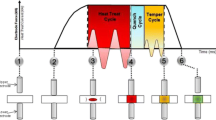Abstract
Considerable attention has been focused recently on the development of higher strength automobile stampings. Traditionally increasing the strength of a stamping has been accomplished by utilizing a higher strength material with its attendant problems in springback, die wear and press loads. An alternative approach to high strength stampings based on thermomechanical (TMT) processing of a low carbon steel is described. With this approach, the contributions to strength due to work hardening during stamping and age hardening after stamping are incorporated into the overall processing scheme. The TMT process consists of heating a low carbon steel to the two phase(α + γ) region and quenching to produce a dispersion of martensite in a ferrite matrix. A second, low temperature heat treatment is then employed to improve the total elongation to acceptable levels. The processed steel is then stamped and subsequently aged at either ambient or elevated temperature to develop final strength. The relative contributions of the individual operations of the TMT process to final strength are discussed and the required heat treatment parameters are evaluated in terms of the operative strengthening mechanisms.
Similar content being viewed by others
References
R. H. Jones:Met. Trans., 1973, vol. 4, p. 2799.
B. I. Edelson and W. M. Baldwin:Trans. ASM, 1962, vol. 55, p. 230.
B. N. Singh, P. Cotterill, and M. B. Waldron:Powder Met, 1969, vol. 12, p. 157.
D. E. Dalton and S. Garber:JISI, 1970, vol. 208, p. 300.
D. E. Dalton and S. Garber:JISI, 1970, vol. 208, p. 633,
J. D. Baird:Met. Rev., 1971, vol. 16, p. 1.
C. A. Wert:Modern Research Techniques in Physical Metallurgy, p. 225, ASM, Cleveland, 1953.
R. de Batist:Internal Friction of Structural Defects in Crystalline Solids, p. 148, North Holland Publishing Co., New York, 1972.
G. M. Leak:The Determination of Gases in Metals, p. 270, Special Report No. 68, The Iron and Steel Institute, London, 1960.
C. A. Wert:Trans. AIME, 1950, vol. 188, p. 1242.
G. Lagerberg and A. Josefsson:Acta Met., 1955, vol. 3, p. 236.
R. R. Judd and H. W. Paxton:Trans. TMS-AIME, 1968, vol. 242, p. 206.
C. S. Roberts, B. L. Averbach, and M. Cohen:Trans. ASM, 1953, vol. 45, p. 576.
B. S. Lement, B. L. Averbach, and M. Cohen:Trans. ASM, 1954, vol. 46, p. 851.
P. M. Kelly and J. Nutting:JISI, 1961, vol. 197, p. 199.
R. Stevenson, G. Thomas, and D. J. Bailey:Met. Trans. A, 1979, vol. 10A, p. 57–62.
P. Stark, B. L. Averbach, and M. Cohen:Acta Met., 1956, vol. 4, p. 91.
E. Conophagos, L. Hyspecka, J. Plusquellec, P. Azou, and P. Bastien:Compt. Rend, Series C, 1972, vol. 274, p. 480.
H. W. King and S. G. Glover:JISI, 1959, vol. 193, p. 123.
G. T. Eldis: Ph.D. Thesis, MIT, 1971.
D. J. Bailey: SAE Preprint 760715, October 18–22,1976.
H. J. Seeman and W. Dickenshied:Acta Met, 1958, vol. 6, p. 62.
J. C. Swarttz:Acta Met., 1969, vol. 17, p. 1511.
Author information
Authors and Affiliations
Additional information
Formerly with the Physics Department, General Motors Research Laboratories
Rights and permissions
About this article
Cite this article
Bailey, D.J., Stevenson, R. High strength low carbon sheet steel by thermomechanical treatment: l. Strengthening mechanisms. Metall Trans A 10, 47–55 (1979). https://doi.org/10.1007/BF02686405
Received:
Issue Date:
DOI: https://doi.org/10.1007/BF02686405




